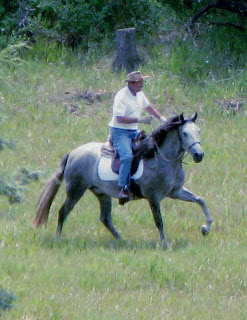| Elba Cruzalta (Bella) gaiting at liberty |
During the Brazilian inspection at age 3, gait is one of the most important dimensions of the test. Horse will be disqualified from permanent breeding registration if they are too lateral (show a pace) or too diagonal (show a trot). Gait counts for 100 points of the 200-point test.
In simple terms, when the greater proportion of time spent with the diagonal legs providing support, the marcha is BATIDA (ba chee da) When the greater proportion of time spent with the lateral legs providing support, the marcha is PICADA (pi ca dah). A few animals have equivalent time spent between diagonal and lateral supports. They are considered to be in the center, sometimes called marcha de CENTRO.
To visualize the spectrum, here is a diagram:
Pace--------picada-----centro-----batida --------Trot
(true lateral) (true diagonal)
Within the gaits, there is a grading system for how comfortable the gait is. L1 to L4 for picada; D1 to D4 for batida. On the diagram, it would look like this:
Pace --–L4-L3-L2-L1-—C—D1-D2-D3-D4----Trot
(true lateral) (true diagonal)
The clinic’s objective was to teach us all how to set the gait correctly (for an untrained horse) and also how to improve the gait. With training, the horse can move 2 steps like from D4 to D2 or L3 to L1.
 |
| Artemis do Summerwind showing triple leg support and the C shape of the front leg |
When the horses are bred close to the center, they may have the ability to perform both gaits – picada and batida. The naturalness of the gait is such that newborn foals will gait rather than walk or run.
No comments:
Post a Comment